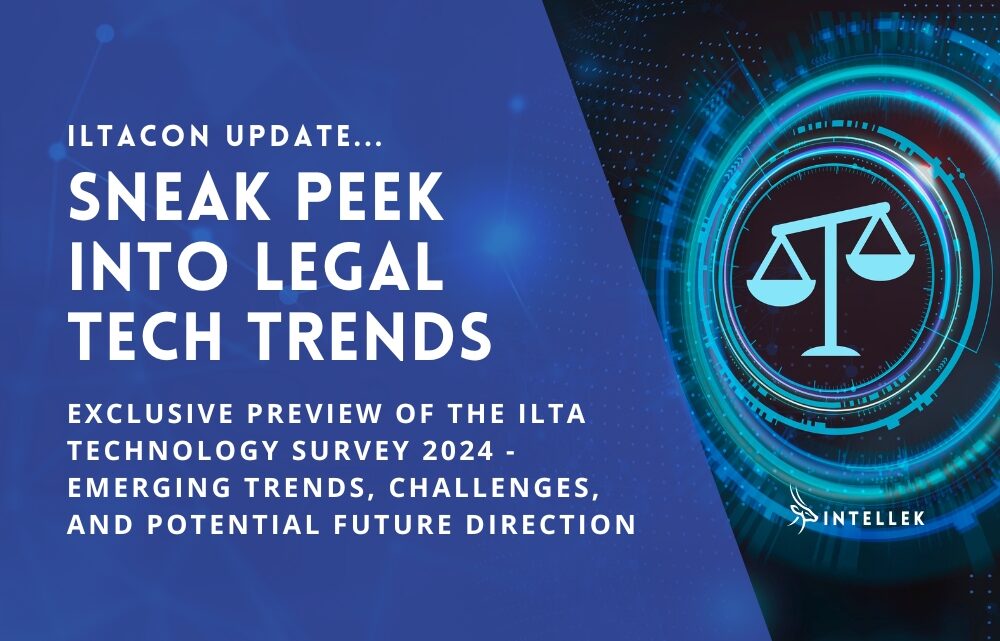
At this year’s ILTACON conference in Nashville, attendees were treated to an exclusive preview of legal tech trends 2024 from the highly anticipated ILTA Technology Survey. The session titled “ILTA’s Technology Survey: Unveiling Trends Shaping the Future Workplace” offered a sneak peek into the Legal Tech trends data that will be finalized and slated for release in September.
IN THIS ARTICLE...
Legal Tech Trends 2024 ILTA Technology Survey Preview
The ILTA Technology Survey Committee has provided an exclusive preview of their 2024 Legal Tech Trends survey results, offering a glimpse into the technological landscape shaping law firms across the United States. This preview session provided valuable insights into the technological landscape of law firms across the United States, highlighting emerging trends, challenges, and potential future directions.
While the full survey results are yet to be published (at the time of writing this article), the preliminary findings shared during the conference have already begun to paint a picture of an industry in transition, working with new technologies and the evolving nature of the legal workplace.
Artificial Intelligence: Early Stages of Adoption
The preview indicates that most firms are still in the investigative phase of AI adoption. However, there are clear indications of interest in specific AI applications in law firms:
- Legal Research: Many firms plan to use AI to enhance legal research processes.
- Litigation Support: There’s significant interest in leveraging AI for litigation-related tasks.
- Staff Training: AI is being considered for improving staff training programs.
Notably, the biggest hurdle to AI adoption is noted as resistance to change within firms.
Cloud Adoption: A Tale of Two Firm Sizes
The preview highlights different approaches to cloud adoption based on firm size:
Small/Medium Firms: These firms are adopting cloud solutions more rapidly, particularly for Document Management Systems (DMS).
Large Firms: While moving towards cloud adoption, larger firms face more complex challenges in transitioning.
Interestingly, a small percentage of firms (2%) still resist cloud adoption, citing client concerns as the primary reason, despite many of these clients already using cloud services themselves.
Law Firm Chatbots: Limited Current Interest
Despite the growing interest in AI technologies, the preview of the ILTA Technology Survey suggests that most firms currently have no plans to implement chatbots. This finding is particularly interesting given the increasing prevalence of chatbots in other industries.
Potential Uses of Chatbots in Law Firms
- Client Intake: Chatbots could streamline the initial client onboarding process, collecting basic information and scheduling appointments.
- Basic Legal Information: They could provide answers to common legal questions, helping potential clients understand basic legal concepts.
- Document Assembly: Chatbots could assist in gathering information needed to populate standard legal documents.
- Internal IT Support: They could handle basic IT queries from staff, reducing the workload on IT departments.
- Case Status Updates: Chatbots could provide clients with updates on their case status without requiring direct attorney involvement.
Reasons for Hesitation to Law Firm Chatbots
- Confidentiality Concerns: Law firms deal with highly sensitive information, and there may be concerns about the security of data handled by chatbots.
- Complexity of Legal Matters: Many legal issues are too nuanced for current chatbot technology to handle accurately, potentially leading to liability issues if incorrect information is provided.
- Personal Touch: Law is often a relationship-driven business, and firms may worry that chatbots could depersonalize client interactions.
- Integration Challenges: Implementing chatbots may require significant changes to existing systems and workflows, which can be costly and time-consuming.
- Ethical Considerations: There may be concerns about whether chatbot interactions could be construed as providing legal advice, which could raise ethical issues.
- Resistance to Change: As noted in the survey preview, resistance to change is a significant hurdle in adopting new technologies, including chatbots.
- Cost vs Benefit: Firms may not yet see a clear return on investment for chatbot technology, especially given the current limitations of the technology.
While chatbots have the potential to improve efficiency in certain areas of legal practice, it appears that most firms are taking a cautious approach. As chatbot technology continues to evolve and as firms become more comfortable with AI technologies in general, this hesitation may decrease. However, for now, the preview suggests that chatbot adoption in law firms remains low, reflecting the unique challenges and considerations of the legal industry.
Other Insights: Security and HR Systems
User behavior is identified as the biggest challenge to firm security, emphasizing the need for ongoing education and robust protocols.
In terms of HR systems, firms are increasingly adopting solutions that offer a wider range of services, including training and development capabilities.
Looking Ahead at Legal Tech Trends
While these insights into 2024’s Legal Tech trends provide valuable preliminary data, it’s important to note that the full ILTA Technology Survey results, to be published in September, may offer more comprehensive and potentially different findings. These early indicators, however, suggest an industry in transition, grappling with the rapid influx of new technologies and the challenges of change management.
The upcoming complete survey results will undoubtedly offer more detailed insights to help firms refine their technology strategies moving forward.
Cloud Migration and AI Training for Law Firms
As the legal sector continues to evolve, firms that can effectively navigate these technological changes while addressing internal resistance will likely be better positioned for future success.
Is your firm in the process of migrating to the cloud? Do your employees need training on safe AI usage at law firms? Is your firm at risk from cybersecurity threats caused by user behavior? Take a look at our extensive eLearning content library to find the latest courses we have on these topics and more of what you need for robust LegalTech learning and development.
Legal Tech Trends 2024: The Full ILTA Report
Since the event, ILTA has released the full report, and we have created the following summary of the findings in legal tech trends for 2024.
Technology Adoption Trends in Law Firms
These are excerpts from the ILTA’s 2024 Technology Survey, highlighting some key trends in technology adoption at law firms and how these trends differ across firm sizes:
Cloud Migration: Law firms are increasingly moving towards cloud-based solutions. For instance:
- DMS/ECM: 72% of firms with under 50 lawyers and 54% with 700 or more lawyers store their DMS/ECM libraries in the cloud. The primary reasons for migrating to cloud-based DMS are the SaaS model and security concerns.
- Time and Billing Systems: While only 41% of smaller firms (under 50 lawyers) currently use cloud-based time and billing systems, this number drops to 4% for larger firms (700+ lawyers). However, when looking at planned replacements, the trend reverses: 97% of small firms and 67% of large firms planning a replacement will opt for a cloud-based solution.
- Other Applications: A large percentage of firms are also using cloud solutions for other functions like email (82% use Microsoft Office 365 or Exchange Online), and hosted VoIP (65% for smaller firms and 44% for larger firms).
Generative AI Adoption: While still in its early stages, the adoption of generative AI tools is growing, with larger firms leading the way. 46% of firms with 150-349 lawyers and 74% of firms with 700 or more lawyers are already using these tools for business tasks. The most popular generative AI tool is ChatGPT.
Laptop Preference: Firms are increasingly opting for laptops over desktops, especially for professional staff. 46% of firms now provide laptops for over 90% of their professional staff, a significant increase from 20% in 2021.
Challenges in Emerging Technology Adoption: The biggest hurdles to adopting emerging technologies like generative AI include user resistance to change, lack of skills/understanding among users, and firm leadership not yet fully bought into the new tech.
Firm Size Impact
The survey data consistently demonstrates that firm size plays a significant role in technology adoption trends.
- Larger firms tend to be early adopters of emerging technologies like generative AI and cloud-based solutions for core functions like conflict management and new business intake.
- Smaller firms show a greater tendency towards a “cloud with every upgrade” approach, suggesting a gradual transition to the cloud.
These differences likely stem from varying resources, risk appetites, and client demands across different firm sizes.
Common and Emerging Legal Technologies
The survey reveals the common software and hardware solutions used by firms of different sizes and provides insight into prevalent and emerging technologies in law firms.
Common Technologies
- Infrastructure: A significant majority of law firms use Microsoft Windows Server as their primary server operating system, with newer versions gaining traction. This indicates a strong reliance on Microsoft’s ecosystem.
- Virtualization: VMware vSAN by Broadcom is the leading hyper-converged technology, suggesting its effectiveness in simplifying IT infrastructure. Additionally, VMware by Broadcom is the dominant server virtualization platform, although firms are considering migrating to alternatives like Microsoft Hyper-V and Nutanix AHV.
- Office Applications: Microsoft Office remains the dominant office application suite, with a trend toward cloud-based Microsoft 365 or Exchange Online. This shift demonstrates the increasing preference for subscription-based models that offer flexibility and scalability.
- DMS/ECM: Cloud-based or SaaS Document Management Systems (DMS) and Enterprise Content Management (ECM) systems are becoming increasingly popular. While concerns about security and performance persist, advantages like improved accessibility, reduced maintenance, and new features are driving this transition.
- Communication and Collaboration: Video conferencing software like Zoom, Microsoft Teams, and GoToMeeting are widely used for remote collaboration. Unified communications technology, particularly Microsoft Teams, is gaining prominence. These tools have become essential for maintaining connectivity and productivity in hybrid work environments.
Emerging Technologies
Generative AI: A growing number of firms are experimenting with generative AI tools like ChatGPT for business tasks, signaling its potential to transform legal practices. Applications include generating strategic ideas, writing code, assisting with presentations, and creating graphics. However, hurdles such as user acceptance, IT staff skills, and securing buy-in from firm leadership remain.
Cloud Migration: The sources indicate a strong trend towards cloud-based solutions across various functions, including accounting and finance, case management, and conflict of interest management. This shift is particularly notable for time and billing systems, where cloud-based solutions are expected to become the dominant choice.
Automation: Law firms are increasingly using software to automate business processes, particularly in areas like document assembly, conflicts of interest management, and new business intake. This trend highlights the need for firms to adopt efficient and streamlined workflows.
Challenges and Opportunities
Security: Cybersecurity remains a major concern for law firms, particularly with the rise of cloud-based solutions and generative AI3031. This necessitates robust security measures, including multi-factor authentication, email encryption, and vulnerability scans323334.
User Adoption: Resistance to change among lawyers and staff can hinder the successful implementation of new technologies35. This underscores the importance of effective change management strategies, comprehensive training, and clear communication about the benefits of new tools.
Skills Gap: The adoption of technologies like generative AI requires IT staff with specialized skills21. Law firms need to invest in upskilling their IT personnel to manage and maintain these emerging technologies effectively.
Cost: While the cloud offers scalability and reduced maintenance, its cost can be a concern for some firms35. Firms need to carefully evaluate the total cost of ownership (TCO) of cloud-based solutions against on-premises alternatives.
Information Governance and Cybersecurity in Law Firms
The ILTA’s 2024 Technology Survey, offers insights into how law firms are approaching information governance and cybersecurity, along with the challenges they encounter.
Information Governance
Cloud-based DMS/ECM Adoption and Concerns: Law firms are increasingly adopting cloud-based Document Management Systems (DMS) and Enterprise Content Management (ECM) systems. In 2024, 72% of firms with under 50 lawyers and 54% of firms with 700 or more lawyers primarily used cloud/SaaS for their DMS/ECM libraries. However, concerns regarding security, performance, and the Patriot Act remain barriers to cloud-based DMS/ECM adoption. Firms are choosing to migrate to the cloud due to the SaaS model, security improvements, total cost of ownership, and the availability of new features.
Ensuring Work Product Storage in DMS: Law firms are employing various strategies to ensure appropriate work product storage in the DMS. The most common methods include training users on information governance, applying pressure from firm leadership, and stressing outside counsel guidelines in policies. Despite technological advancements, law firms still heavily rely on lawyers to fulfill governance requirements for managing work.
Cybersecurity
Top Security Challenges: The most significant security challenges faced by law firms are user behavior and compliance/enforcement. Other major concerns include malware/virus/zero-day threats and data loss/leakage prevention. This highlights the importance of training and robust security protocols.
Security Measures: Law firms are implementing a range of security measures beyond encryption and workstation security software. The most common measures include admin/privileged account or password management, advanced threat protection, and application control/application whitelisting.
Outsourced Security Functions: Law firms are increasingly outsourcing security functions to vendor partners. Commonly outsourced functions include security awareness training, threat monitoring and analysis, and incident response.
Work-from-Home Security Concerns: In the hybrid work model, the top security concerns for law firms are data leakage via removable media, equipment provisioning and collection, and authenticating users. These concerns underscore the need for secure remote access solutions and policies.
Key Observations
Cloud adoption is transforming information governance and cybersecurity in law firms. While this brings benefits, it also introduces new challenges related to data security and compliance.
Human behavior remains a significant security risk. This emphasizes the need for ongoing security awareness training and clear policies to mitigate user-induced vulnerabilities.
Law firms are increasingly relying on managed security service providers (MSSPs) to address the evolving threat landscape and manage complex security infrastructure.
Legal Tech Trends 2024 Snapshot
The survey provides a snapshot of current legal tech trends for 2024 and associated challenges. However, the legal technology landscape is constantly evolving, and further research may be required to stay abreast of the latest developments in information governance and cybersecurity for law firms.
Overall, the legal tech trends 2024 survey report indicates that law firms are embracing technological advancements to improve efficiency, collaboration, and client service. However, successful implementation requires addressing challenges related to security, user adoption, skills, and cost. By navigating these challenges strategically, firms can leverage technology to gain a competitive edge and succeed in the evolving legal landscape.


Ricci Masero is an accomplished Chartered Marketer and content creator with over 25 years of experience in the field. Alongside marketing the award-winning blended learning solutions from Intellek, Ricci has been writing about technology and innovation for many years – his thought leadership has featured in Forbes, Entrepreneur, Alassian, and AI Journal – as an author, he is a regular contributor to eLearning Industry, Training Journal, and many other industry publications. He is also co-host of the L&D Insights segment in Intellek’s client webinars.





